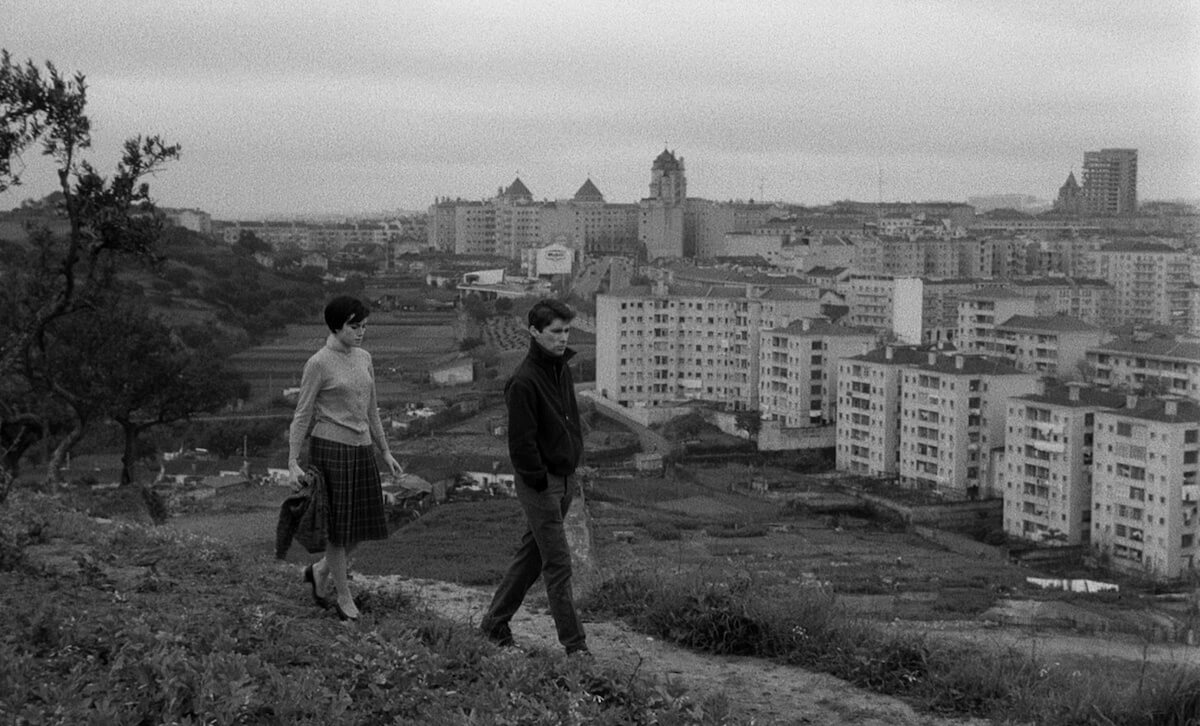
Lisbon. Paris. Boston. Sleek, overwhelming metropolises built as monuments to mankind’s triumph over the industrial process. Lest we forget, however, the population move from the rural countryside to modern urban centers only came about — depending on where you live — a century ago. This move toward modernity brought about a special breed of urban ennui showcased throughout the cinema of the 20th-and-early-21st century. A distinct example of this migration can be found in writer-director Paulo Rocha’s recently restored debut, The Green Years (Os Verdes Anos, 1963), a mesmerizing Portuguese classic which focuses on the intersection of the rural-working class and urban solitude. Never before screened in the United States, The Green Years is an extraordinary coming-of-age film ripe for rediscovery.
Nineteen-year-old Julio (Rui Gomes) has recently arrived for the first-time in Lisbon, migrating from the Portuguese countryside to work as a shoemaker for his uncle, Raul (Ruy Furtado). The workplace is dingy, his co-workers are crude, and Julio is lonely, but it’s a well-paying job for a boy used to provincial work. That loneliness is quickly replaced by tentative romance when he meets Ilda (Isabel Ruth), a young housemaid for an upper-class couple, who is a regular patron to the store. Like Julio, Ilda has also arrived from the countryside, and the pair quickly become entangled in a burgeoning relationship. Like a first-love’s travelogue, Ilda guides Julio to-and-fro between old-fashioned pubs and higher-class establishments, making her aspirational affection for the upper-class well-known. This promising romance slowly unravels as the divide between Julio and Ilda becomes too obvious to ignore .
Rocha and co-writer Nuno Braganca’s script is admirably cognizant of its underlying theme of urban alienation. Take notice of Julio’s introductory scene, where he is standing alone at a Lisbon train station, smoke enveloping his body, as Rocha’s camera lingers over a full-shot of his slouching, pitiful figure. As a group of apathetic pedestrians move past the lone boy, Julio desperately wanders around looking for his uncle, who in a drunken stupor has forgotten to pick him up. He is subsequently approached by another forlorn soul who mutters a piece of advice foreshadowing the film’s thematic preoccupations: “This city has devoured many.” Our first experience with the young provincial is a stark declaration for both the viewer and Julio — Lisbon’s modern, sleek exterior masks the fatalistic environment to follow.
Key to developing his image of a bleak Lisbon is both Rocha’s postcard-like compositions and impeccable staging. The first act of the movie centered on the couple’s brewing romance, is luminously shot in black-and-white by cinematographer Luc Minot; by the latter-half, however, we move away from this narrative and instead focus on Julio’s loneliness vis á vis Lisbon’s natural mise-en-scène. Many scenes operate with little-to-no dialogue and are only accompanied by composer Carlos Paredes’ mournful guitar, adeptly expressing Julio’s bittersweet relationship with Ilda and the city. Even more significant, however, is Rocha’s first-rate use of staging to visually represent the growing divide in Julio and Ilda’s relationship. Ilda’s job has her living and working among the upper-class, a group that she has subtly integrated into with finesse.
Alternatively, there is Julio, whose rudimentary knowledge of the affluent extends to watching the privileged eat high-end meals and drive fashionable cars he could never own. At one point, Ilda puts on a fashion show for Julio, using her employer’s wardrobe. Treating her humble bedroom as a runway, Ilda maneuvers in-and-out of one high-priced dress to another. Her attempt to seduce Julio doesn’t quite work out: the drab adolescent, looking face-down and ignoring Ilda, can only squirm around in his seat. Rui Gomes’ awkward disposition perfectly counterbalances the remarkably self-assured Isabel Ruth, each moving differently through the same environment. Gomes and Ruth’s mannered performances blend seamlessly into Lisbon’s stark landscape, with both portraying equal levels of naivety and energy to keep us convinced by the film’s world. Through these layered performances, we come to understand how the gradual, cumulative toll of city life can affect every individual quite differently.
Beyond being an inciting work of the New Portuguese cinema (also known as Cinema Novo), The Green Years is quite simply a remarkable piece of cinematic beauty. The movie calls to mind contemporary works such as Tsai Ming-Ling’s Rebels of the Neon God (1992) and Sofia Coppola’s Lost in Translation (2004), both of which probed the paradox of human isolation in times of constant stimulation. Despite the film’s musings on modern disillusionment, it’s hard to ignore the overwhelming element of romantic nostalgia scattered throughout the work. Shots of beer bottles, wide-open fields, and drunken singing humorously contrast the film’s fatalistic overtones and situate the audience in a unique time-and-place. Long-cited as an inspiration by Portuguese filmmakers such as Pedro Costa and Manoel De Oliveira, Rocha’s foundational work can now be purchased through Grasshopper Films. A moment to rejoice in!